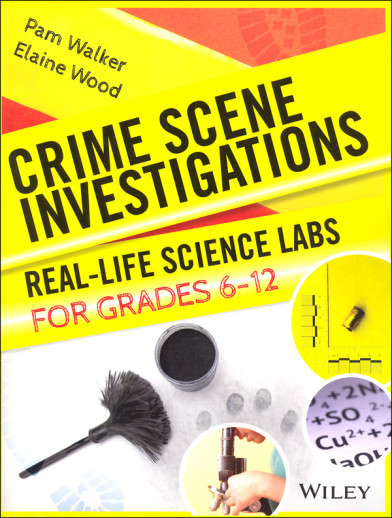We use cookies to make your experience better. To comply with the new e-Privacy directive, we need to ask for your consent to set the cookies. Learn more.
Crime Scene Investigations: Real-Life Science Labs for Grades 6-12
If your family is like mine - captivated by the real science behind the plethora of television crime shows, then this book may be perfect for you. This resource brings the scientific study of crime scenes into the home and school arena. While the labs are designed for groups, you can easily do these as a family (or in a co-op) if you are willing to invest the time to set the crime scene stage.
Divided into 4 sections, each covers a different branch of science. The first section, Critical Thinking, lays the foundational principles of science and reinforces observation skills (handwriting and typewriting comparisons,) experimentation (shoe impressions) and logical thinking. Physical Science employs techniques such as analysis of unknown mixtures, fibers and fingerprinting. In the Life Science section, students concentrate on evidence left at crime sciences by living things and study the principles of inheritance, DNA, blood typing, dental identification, and forensic etymology. The final section, Earth Science, offers lessons on mummification, skeletal evidence, and archaeological evidence. All in all, this supplemental resource book offers 68 lessons and labs (most lessons have one accompanying lab, some have two) designed to bring a fresh enthusiasm on the importance of "whys" of learning science. Household items and additional lab equipment required (microscope, glass slides and cover slips, test tubes, pH paper, beakers, filter paper, Plaster of Paris, and various chemicals. Information to order an Edvotek DNA Kit is included for the DNA labs).
A brief personal note, I used the previous edition of this book with my teens and they still talk about the science they learned. Real life science learned and remembered makes for one happy homeschool mom! We performed the majority of activities in the book, making changes to the readily available supplies, some of the experiments we discussed and did not perform due to the difficulty of obtaining materials. Noteworthy:while the mock crimes are presented in a discerning manner, they do represent a wide variety of fact- based crimes. As a family, you may elect to skip over some of the lessons within the pages. Reproducible for classroom use. sc ~Deanne
This unique resource offers activities in earth, life, and physical science as well as science inquiry and technology. The Grades 6-12 level book provides labs on life, physical, and earth science as well as critical thinking. Like real-life forensic scientists, students observe carefully, organize, and record data, think critically, and conduct simple tests to solve crimes like theft, dog-napping, vandalism and water pollution. For added fun, each resource features an original cartoon character, Investi Gator for the Elementary level and Crime Cat for Grades 6-12. All activities include complete background information with step-by-step procedures for the teacher and reproducible student worksheets. Whatever the teacher's training or experience in teaching science, Crime Scene Investigations can be an intriguing supplement to instruction.
| Product Format: | Paperback |
|---|---|
| Brand: | Jossey-Bass |
| Author: | Pam Walker & Elaine Wood |
| Grades: | 6-12 |
| ISBN: | 9780787966300 |
| Length in Inches: | 10.875 |
| Width in Inches: | 8.25 |
| Height in Inches: | 0.625 |
| Weight in Pounds: | 1.5 |

